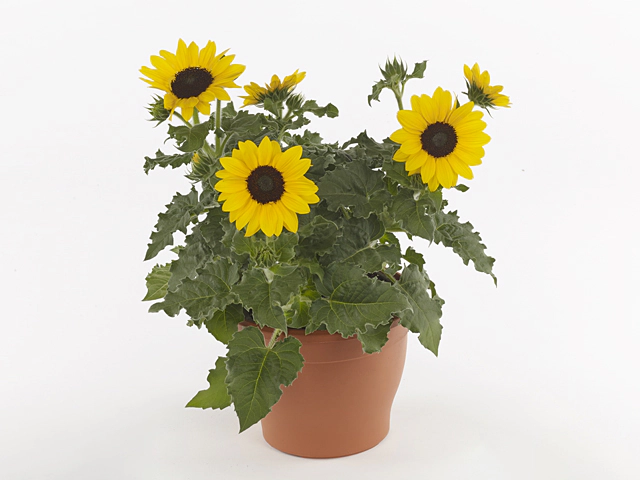Helianthus annuus Sunblast

| Leaf tip | Pointed/acute |
| Flower type | Single |
| Leaf margin | Serrate; Undulate |
| Winter hardness | Not hardy (USDA-zone 9,10,11) |
| Flower color | Yellow-dark yellow-013A |
| Soil fertility | Special demands |
| Leaf, general shape | Cordate (heart-shaped) |
| Flower diameter | 9,5 - 10 cm |
| Plant height | 30 - 40 cm; 70 - 80 cm; 60 - 70 cm |
| Inflorescence | Capitulum (head) |
| Flowering month(s) | May; June; July; August; September |
| Inflorescence/Flower arrangement | erect; obliquely erect |
| Leaf size | 7,5 - 10 cm |
| soil pH requirement | Neutral (pH 6,5 - 7,5); Alkaline (pH > 7,5) |
| Leaf, main color | Dark green |
Helianthus annuus Sunblast, also known as the Sunflower, is a beautiful and versatile plant that adds a pop of vibrant yellow to any garden or landscape. With its pointed or acute leaf tips and serrate, undulate leaf margins, this sunflower variety stands out from the rest.
Although it is not winter hardy in USDA zones 9, 10, and 11, Sunblast makes up for it with its stunning flower color. The petals range from a bright yellow to a dark yellow, with a shade designation of 013A. This variation in color adds depth and interest to the plant, making it a visual standout in any setting.
When it comes to soil fertility, Sunblast has special demands. It thrives in nutrient-rich soil, so proper care and attention should be given to ensure optimal growth. Additionally, the plant prefers a neutral to alkaline pH level, with a range of 6.5 to 7.5. This information is essential for gardeners looking to cultivate a thriving Sunblast sunflower.
In terms of size, Sunblast has a heart-shaped or cordate general leaf shape with a size range of 7.5 to 10 cm. The flower, with a diameter of 9.5 to 10 cm, sits atop a plant that can reach a height of 30 to 40 cm, 70 to 80 cm, or 60 to 70 cm, depending on the specific variety chosen. This versatility in height allows gardeners to select the perfect size for their space.
The inflorescence of Sunblast sunflowers is in the form of a capitulum or head. These flower heads are held erect or obliquely erect, adding a unique visual element to the plant. When it comes to flowering, Sunblast blooms from May to September, providing an extended period of enjoyment for both gardeners and pollinators.
In conclusion, Helianthus annuus Sunblast, commonly known as the Sunflower, is a stunning addition to any garden or landscape. With its pointed leaves, serrate, undulate margins, and heart-shaped appearance, this plant stands out from the crowd. Its bright yellow to dark yellow flowers bring a burst of color, while its special soil fertility demands and pH requirements ensure optimal growth. With a range of heights and a long flowering season, the Sunblast sunflower is a must-have for any garden enthusiast.
Market availability index by month:
| Jan. | Feb. | Mar. | Apr. | May | Jun. | Jul. | Aug. | Sep. | Oct. | Nov. | Dec. |
|---|---|---|---|---|---|---|---|---|---|---|---|
| - | - | 1 | 2 | 4 | 4 | 3 | 2 | - | - | 1 | - |